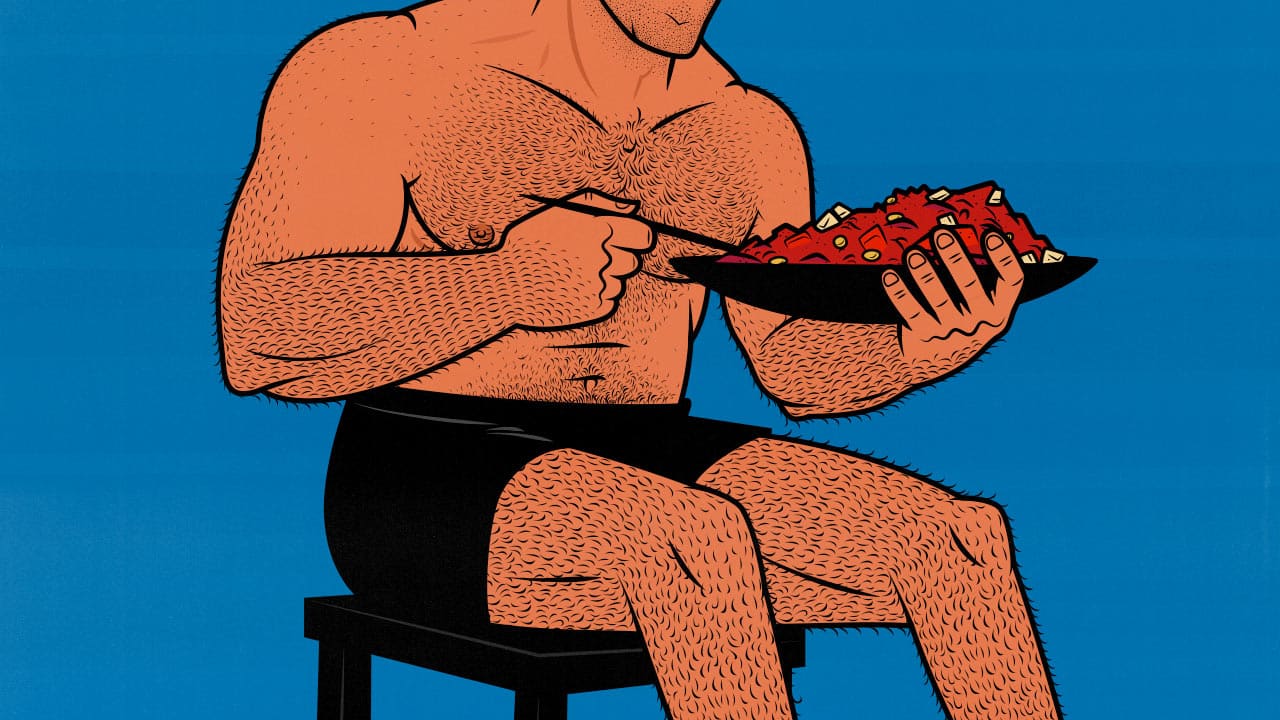Posts by Shane Duquette
Why Aren’t You Gaining Weight in a Calorie Surplus?
You used a bulking calorie calculator, which told you how many calories you needed to gain weight. Then, you meticulously tracked your calories for several weeks, logging every single food that went into your mouth. And yet, somehow, you haven’t gained any weight. Or perhaps you gained weight during the first few weeks, but now the fount has run dry.
I struggled with this for years. It’s one of the most common questions we get from skinny clients. It’s rooted in a basic misunderstanding, and the solution is very simple, but you won’t like it.
Read MoreHigh-Calorie, High-Protein Vegan Bulking Meal Plan (With Recipes)
We’ve already covered whether vegan diets are good for building muscle and explained how to bulk on a plant-based diet. Now, let’s give you a full meal plan, complete with recipes and macros. All of these recipes are nutritious, high in calories, and high in protein.
You might worry you won’t get enough protein, but most plant-based foods have some protein, and with all these extra calories coming in, it adds up quickly. I think you’ll be surprised at how simple this can be.
If you make your diet out of these meals, they’ll give you 3,000 calories and nearly 200 grams of protein. That’s way more than enough protein to maximize your rate of muscle growth. We can adjust the calories from there to make sure you’re gaining weight at the right pace.
Read MoreThe Vertical Diet: Full Overview & Review
The Vertical Diet is a bulking diet designed to help people get bigger, stronger, and fitter. It’s supposed to make it easier to eat enough food to gain weight, thus supporting muscle growth and strength gains.
The diet is especially popular with professional bodybuilders and strongmen who use performance-enhancing drugs. Stan Efferding says he invented the diet to mitigate the harms of those lifestyles. But it’s supposed to be healthy for everyone. Is it?
We’re natural lifters, and we’re more interested in health than professional bodybuilding, but we’ve helped college, professional, and Olympic athletes bulk up. We know how to train and diet for elite performance.
Here’s our overview and review of the Vertical Diet.
Read MoreWhat’s the Best Way to Bulk Up?
There are a few different ways to bulk. You could bulk dirty or cleanly, aggressive or leanly, or anywhere in between. I’ll explain the pros and each so that you can pick the style of bulking that’s best for you.
We’ve been helping people bulk up for over a decade now, with clients ranging from geriatric deskworkers all the way to college, professional, and Olympic athletes. We can help you to do it, too. The results are incredibly consistent.
Read MoreThe Best High-Calorie Bulking Meals (With Recipes)
One of our most popular articles is about how to eat a good bulking diet. It covers all the most important principles—how to choose nutritious foods, what macros to aim for, how to calculate your calorie needs, how to adjust those calories based on your results (or lack thereof), and so much more.
However, it doesn’t give many examples of good bulking meals, and it doesn’t have any recipes. That’s where this article comes in. These are some of my favourite bulking meals. I’ve used them to gain 70 pounds, and we’ve been using them with clients for over a decade now. I’ll give you recipes for all of them, with the calories and macros calculated out.
Feel free to ask questions. I’ll answer all the comments.
Read MoreCan You Build Muscle on a Vegan Diet?
There’s been some drama about a study by Pinckaers and colleagues. It found that plant-based protein wasn’t as good as animal protein for stimulating muscle protein synthesis. This is just one of many studies, and a larger meta-analysis found that plant-based protein sources stimulate muscle-protein synthesis just fine. The latest 2025 study also found no differences (study). But these aren’t the types of studies we should be looking at.
To see if vegan diets are good for building muscle, it’s much better to look at studies that measure actual muscle growth. Fortunately, there are quite a few of them.
Read MoreHow Much Protein Should You Eat at Breakfast to Build Muscle?
There are two recent studies that I found interesting. The first looked at whether going from a low-protein breakfast to a moderate-protein breakfast would improve muscle growth. The second looked at the effects of going from a moderate amount of protein to a massive amount of protein.
If we look at both studies, we get a pretty good idea of how much protein you should eat at breakfast.
Read MoreHow We Went From Skinny to Muscular (+70 Pounds of Muscle)
Jared and I were skinny graphic designers. We didn’t know anyone who ate a good diet, lifted weights, or exercised. We didn’t know anyone fit or muscular. But I was clinically underweight and suffering from early signs of cardiovascular disease, and Jared had crippling tendonitis that prevented him from working his desk job.
We didn’t know anything about building muscle. I thought we could gain all the muscle we needed with a 30-day bulking challenge, and I convinced Jared to try it with me. That’s how “Muscle May” began. That’s what inspired our entire Bony to Beastly business.
After 30 days, we’d gained over thirty pounds between us. It was working. We were finally gaining weight! So we doubled down, extending our pact for another three months. By the end of those three months, we’d gained almost 60 pounds of muscle between us. Since then, I’ve gained another 30 pounds.
Here’s the full story of how we went from skinny to muscular.
Read MoreThe Best Side Delt Exercises Are Weird Lateral Raises
The overhead press is the best overall shoulder exercise. If you want a minimalist workout routine, that’s all you need. If you really want to build bigger side delts, though, it pays to include an exercise that trains them directly.
Lateral raises are the best exercise for your side delts, and they can take you quite far, but you can do even better. Lateral raises are easy to improve upon. Here’s how.
Read MoreShould You Lift More Weight or Do More Reps to Build Muscle?
The top search result for this question is wrong, and it’s bugging me. There’s this old myth that heavier weights are better for building muscle while lighter weights are better for gaining endurance. That’s not quite right.
Both low-rep and high-rep sets can be equally good for building muscle. Anywhere from 4–40 reps per set stimulates a similar amount of muscle growth. Doing 6–20 reps tends to be a little easier and more efficient. Most bodybuilders lift right in the middle, favouring 8–12 reps.
However, different rep ranges provoke slightly different adaptations. The best way to build muscle is to take advantage of both. A balanced muscle-building program will use a mix of heavier weights and higher reps. More on that in a moment.
This begs another question: when you progressively overload your exercises, should you focus on adding more weight or adding more reps? Both can be equally good for building muscle. It all depends on what exercise you’re doing and what you’re trying to accomplish.
Read More









